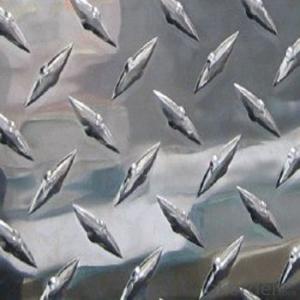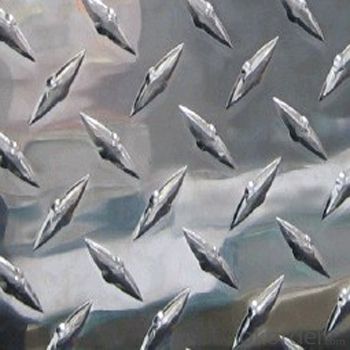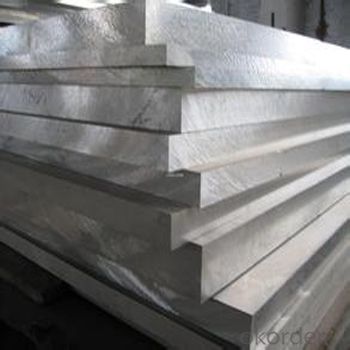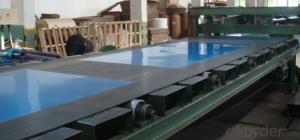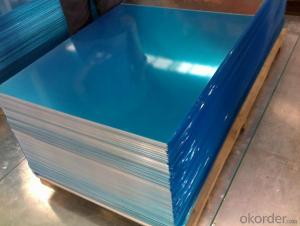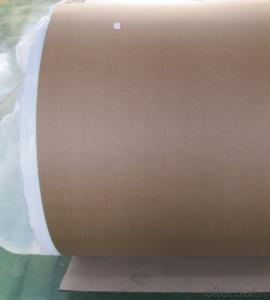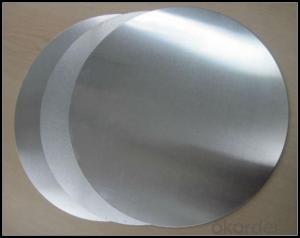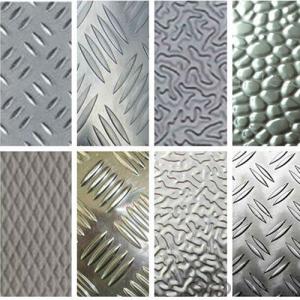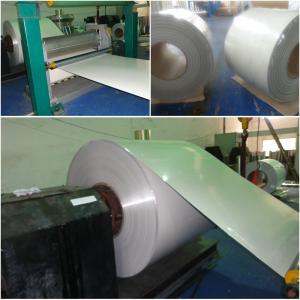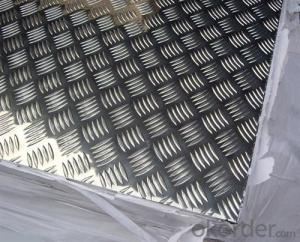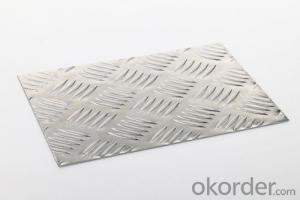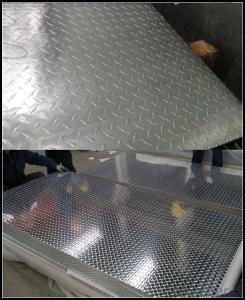Embossed Aluminum Tread Plate Sheets Coil Foil Strip
- Loading Port:
- Shanghai
- Payment Terms:
- TT or LC
- Min Order Qty:
- 3 m.t.
- Supply Capability:
- 300 m.t./month
OKorder Service Pledge
OKorder Financial Service
You Might Also Like
1.Description
Aluminium foil (or aluminum foil) is aluminium prepared in thin metal leaves with a thickness less than 0.2 millimetres (8 mils); thinner gauges down to 6 micrometres (0.24 mils) are also commonly used.In the United States, foils are commonly gauged in thousandths of an inch or mils. Standard household foil is typically 0.016 mm (0.63 mils) thick, and heavy duty household foil is typically 0.024 mm (0.94 mils). Thefoil is pliable, and can be readily bent or wrapped around objects. Thin foils are fragile and are sometimeslaminated to other materials such as plastics or paper to make them more useful. Aluminium foil supplantedtin foil in the mid 20th century.
Annual production of aluminium foil was approximately 800,000 tonnes (880,000 tons) in Europe and 600,000 tonnes (660,000 tons) in the U.S. in 2003. Approximately 75% of aluminium foil is used for packaging offoods, cosmetics, and chemical products, and 25% used for industrial applications (e.g. thermal insulation, cables and electronics).
In North America, aluminium foil is known as aluminum foil. It was popularized by Reynolds Metals, the leading manufacturer in North America. In the United Kingdom and United States it is, informally, widely called tin foil, for historical reasons (similar to how aluminum cans are often still called "tin cans").Metallised films are sometimes mistaken for aluminium foil, but are actually polymer films coated with a thin layer of aluminium. In Australia, aluminium foil is widely called alfoil.
2. Our advantage:
We can supply best quality and best price!
3.Specification and application
EMBOSSED ALUMINIUM SHEET EMBOSSED ALUMINIUM SHEETS ALUMINIUM SHEETS
ALLOY : AA1***(AA1050,AA1060,AA1070,AA1100etc)
AA3***(AA3003,AA3004,AA3005,AA3105etc)
AA5***(AA5052 etc)
TEMPER:H14,H18,H24,H26,H32
THICKNESS:0.2mm-20mm
WIDTH:10mm-1500mm
EMBOSSED PATTERNS : Diamond, stucoo,bars etc
STANDARD: GB/T3880-2006
Special specification is available on customer's requirement
ALUMINIUM CIRCLE
ALLOY:AA1***(AA1050,AA1070,AA1100etc)
AA3***(AA3003 etc)
TEMPER:O,H14
THICKNESS:0.5mm-4mm
DIAGONAL:100mm-1200mm
STANDARD:GB/T 3880-2006
Special specification is available on customer's requirement
4.Pictures

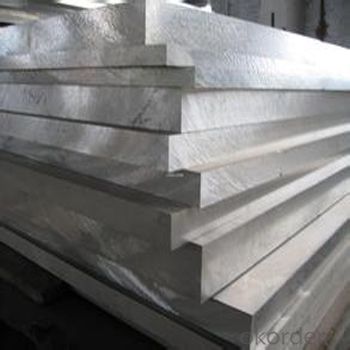
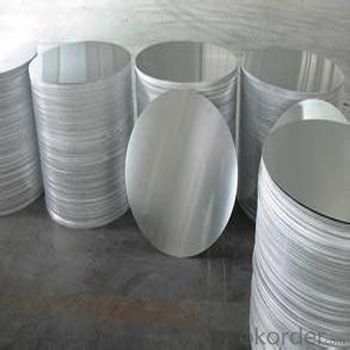
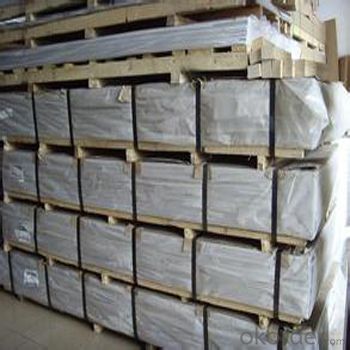
5.FAQ
1)How about our payment term?
LC and TT and other.
2)Which country can we supply?
All around the world!
- Q: For my chem class that I just barely started taking, we're making bohr models. Even though my teacher explained it, I still dont get the concept of it all, like how the protons are lined up in their inner circle and the outer circles. I get everythign else about atoms except how they're actually made up lol. Maybe someone on here can explain it to me? I hope so because i have to make a model for it for friday.The element I'm asigned is aluminum btwYour help is greatly appreciated!
- Niels Bohr thought that the electrons orbited the nucleus of the atom similar to how the planets orbit the sun. He thought the electrons had a fixed path which he called orbits and that they each electron had a fixed amount of energy.
- Q: How could two pieces of aluminium flakes be welded together?
- You can use argon arc welding, connect the positive pole with alternating current,aluminum wire as the welding wire.
- Q: Are aluminum sheets suitable for insulation cladding?
- Yes, aluminum sheets are suitable for insulation cladding. Aluminum is a lightweight, durable, and corrosion-resistant material that can effectively protect and insulate buildings. It provides excellent thermal and sound insulation properties, making it an ideal choice for cladding systems. Additionally, aluminum sheets are easy to install, maintain, and are available in various finishes and colors, allowing for design flexibility.
- Q: How is the thickness of an aluminum sheet measured?
- Various methods can be employed to measure the thickness of an aluminum sheet. One commonly used technique involves the utilization of precision measuring tools like a micrometer or caliper. By placing the micrometer on one end of the sheet and gradually closing it until it reaches the other end, an accurate measurement of the thickness can be obtained. This particular method is suitable for thin aluminum sheets. For thicker sheets, a thickness gauge can be utilized. This gauge consists of a compact handheld device equipped with a probe that is pressed against the surface of the sheet. The gauge then displays the thickness reading on a screen. This approach proves especially advantageous when measuring thicker sheets as a micrometer or caliper may not be feasible. An alternative means of measuring the thickness of an aluminum sheet involves the use of an ultrasonic thickness gauge. This tool emits ultrasonic waves from a transducer, which are subsequently reflected back from the surface of the sheet. By calculating the time taken for the waves to travel and return, the gauge can determine the thickness of the sheet with great accuracy. This method is particularly effective for measuring the thickness of large or irregularly shaped aluminum sheets. To summarize, the thickness of an aluminum sheet can be determined using a variety of tools such as a micrometer, caliper, thickness gauge, or ultrasonic thickness gauge, depending on the thickness and size of the sheet.
- Q: My aluminum storm windows are wasting energy in my home, however, the $7000 estimate to replace them is beyond (well beyond) my comfort zone.I know aluminum is a great conductor of hot and cold. I was considering cleaning the frames, and then coating them with a brush on clear or possibly white liquid rubber to reduce the conductivity. Any idea as to how much benefit I'll realize? Is flammability going to be an issue?I need some solid answers please. Trolls go get your two points elsewhere.Thanks.Your help is much appreciated.
- LJR, There could be no issues concerning reactivity or flammability with reference to putting some sort of liquid rubber coating on your aluminum window frames. Aluminum is a reasonably inert steel, or maybe has a skinny coating of aluminum oxide on its floor that reduces its reactivity much extra. Coating it with something could be completely secure. to whether you will attain reward from doing it relies upon on the layout of your dwelling house windows. i do no longer understand lots approximately dwelling house advancements, so i can not truthfully image how they're set up. in case you may coat the frames each and all of the way around so as that there isn't any way for the aluminum to habit warmth from the outer portion of the window to the interior portion of the window, then this could be fairly efficient. yet whilst portion of the frames are embedded interior the wood such which you would be able to no longer get right of entry to it to place a coating on, then coating something of them won't do lots sturdy. honestly, while you're effective which you would be able to coat the entire physique and placed it returned in the way it grew to become into, i might circulate forward and do it. If no longer, i might ask somebody at a ironmongery shop approximately different suggestions.
- Q: I would like to use an alloy of copper often called aluminum bronze or aluminum brass for making wire wrapped jewelry but I am unable to find a supplier. An alloy that has no zinc or lead would be best to avoid toxicity problems. This alloy should be principally copper and aluminum but other added materials would be acceptable if not toxic. Nickel, silicon, manganese, and iron are sometimes added to increase performance of the alloy and should be acceptable (no lead or zinc please). The material obviously needs to be bendable enough to work with wire wrapping so if it is brittle it will not work. It should then be at least as usable as aluminum, copper, or stainless steel wire.
- Aluminum okorder which is a site for serious jewelers to share solutions and they might have an answer.
- Q: What are the different types of alloys used for powder-coated aluminum sheets?
- There are several different types of alloys used for powder-coated aluminum sheets, each with its own unique set of properties and characteristics. Some of the most commonly used alloys include: 1. 3003 Alloy: This alloy is one of the most widely used for powder-coated aluminum sheets. It offers good corrosion resistance, excellent formability, and high strength. It is often used in applications that require moderate strength and resistance to atmospheric corrosion, such as building facades, signage, and automotive parts. 2. 5052 Alloy: This alloy is known for its high strength and excellent corrosion resistance. It is often used in marine and architectural applications where durability and resistance to saltwater and harsh environments are essential. It is also commonly used in the manufacturing of electrical enclosures and transportation equipment. 3. 6061 Alloy: This alloy is highly versatile and offers excellent weldability, formability, and machinability. It is often used in a wide range of applications, including aerospace components, marine hardware, structural components, and automotive parts. It has good corrosion resistance and can be easily powder-coated to enhance its appearance and provide additional protection. 4. 7075 Alloy: This alloy is known for its high strength-to-weight ratio and excellent fatigue resistance. It is commonly used in aerospace applications, such as aircraft fittings and structural components, where strength and lightweight properties are crucial. Although it is less commonly used for powder-coated aluminum sheets due to its higher cost, it can still be found in certain specialized applications. These are just a few examples of the different types of alloys used for powder-coated aluminum sheets. The choice of alloy depends on the specific requirements of the application, including factors such as strength, corrosion resistance, formability, and cost.
- Q: What is the weight per square foot of 101 aluminum sheets?
- The weight per square foot of 101 aluminum sheets can vary depending on the thickness of the sheets. Generally, the weight of aluminum is measured in pounds per square foot (lbs/ft²). To determine the exact weight per square foot of 101 aluminum sheets, you would need to know the thickness of each sheet. Once you have the thickness, you can use the density of aluminum, which is approximately 0.098 pounds per cubic inch (lbs/in³), to calculate the weight per square foot.
- Q: What are the different types of surface treatments available for powder-coated aluminum sheets?
- There are several different types of surface treatments available for powder-coated aluminum sheets. Some of the most common options include anodizing, chemical etching, and mechanical finishing. Anodizing is a process that involves immersing the aluminum sheets in an electrolytic solution and applying an electric current to create a protective oxide layer on the surface. This treatment can enhance the durability and corrosion resistance of the aluminum, as well as provide a decorative finish with a wide range of colors. Chemical etching is another surface treatment method that involves applying a chemical solution to the aluminum sheets to create a textured or patterned surface. This process can be used to create unique designs and improve the aesthetics of the material. Mechanical finishing techniques, such as brushing or polishing, can also be used to enhance the appearance and texture of powder-coated aluminum sheets. Brushing creates a brushed or linear pattern on the surface, while polishing creates a smooth and glossy finish. Additionally, there are specialized surface treatments available for specific applications, such as chromate conversion coating for improved adhesion of adhesives or paints, or clear coatings for added protection against UV radiation. Overall, the choice of surface treatment for powder-coated aluminum sheets depends on the desired aesthetic, functionality, and durability requirements of the application.
- Q: What are the common thicknesses of aluminum sheets used in construction?
- The common thicknesses of aluminum sheets used in construction vary depending on the specific application and requirements. However, some commonly used thicknesses include 0.032 inches (0.81mm), 0.040 inches (1.02mm), 0.050 inches (1.27mm), and 0.063 inches (1.60mm). These thicknesses are often used for architectural applications such as wall panels, roofing, and siding. Thicker aluminum sheets, such as 0.080 inches (2.03mm) and 0.125 inches (3.18mm), are also used in heavier construction applications such as structural components, support beams, and decking. It is important to note that these thicknesses are just examples and can vary depending on the specific project requirements and engineering specifications.
Send your message to us
Embossed Aluminum Tread Plate Sheets Coil Foil Strip
- Loading Port:
- Shanghai
- Payment Terms:
- TT or LC
- Min Order Qty:
- 3 m.t.
- Supply Capability:
- 300 m.t./month
OKorder Service Pledge
OKorder Financial Service
Similar products
Hot products
Hot Searches
Related keywords
